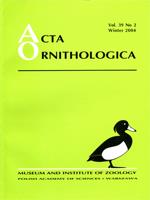The study was conducted from 1997–2001 in the city of Słupsk. Observations of individually marked birds were conducted from blinds located at city-centre sites where Feral Pigeons breed. The pigeons bred throughout the year, with peak broods in spring and summer. Different pairs timed their breeding such that the beginning of the season (from October to September of the next calendar year) overlapped the dates of completion (from April to December). 10% of pairs had already begun breeding in the autumn, while 86% did so between January and May. The remaining pairs (young ones, in particular) started breeding even later, mainly because of the lack of suitable nesting sites. The breeding period most often ended between August and October (75% of pairs), when the pigeons began their moult. 91% of the young birds joined the breeding population in their second calendar year of life. The remaining young birds had their first broods in the first or third calendar year of life. Pairs of young birds started nesting 2–3 months later than adult birds. The average length of a pair's breeding season was 183 days.
How to translate text using browser tools
1 December 2004
Timing of Breeding in the Feral Pigeon Columba livia f. domestica in Słupsk (Nw Poland)
Tomasz Hetmański
J. Dabert
1987. Breeding ecology of the feral pigeon Columba livia f. domestica in Poznań, Poland. Acta Ornithol. 23: 177–195. Google Scholar
P. J. Dilks
1975. The breeding of the feral pigeon (Columba livia) in Hawke's Bay, New Zealand. Notornis 22: 295–301. Google Scholar
R. Dunmore
,
D. Davis
1963. Reproductive condition of feral pigeons in winter. Auk 80: 374. Google Scholar
A. Erskine
1976. Chronology of nesting in urban birds as a guide to timing of censuses. Amer. Birds 30: 667–672. Google Scholar
D. Goodwin
1960. Comparative ecology of pigeons in inner London. Brit. Birds 53: 201–212. Google Scholar
D. Haag
1988. Die dichteabhängige Regulation im Brutschwarm der Strassentaube Columba livia forma domestica. Ornithol. Beob. 85: 209–224. Google Scholar
D. Haag-Wackernagel
1998. Ecology of Feral Pigeons in Basel, Switzerland. In:
A. Farina
,
J. Kennedy
,
V. Bossú
(eds).,
Proc. VII Intern. Congr. Ecol., Florence, pp: 1–4. Google Scholar
I. Häkkinen
,
M. Jokinen
,
J. Tast
1973. The winter breeding of the feral pigeon Columba livia domestica at Tampere in 1972/73. Ornis Fennica 50: 83–88. Google Scholar
M. Janiga
1985. The connections between the climatic factors and the natality of feral pigeon (Columba livia f. domestica) in Bratislava. Biológia (Bratislava) 40: 583–590. Google Scholar
M. Janiga
,
L. Kocian
1985. Some aspects of the nidobiology of the pigeon (Columba livia f. domestica) in Bratislava. Folia Zool. 34: 133–147. Google Scholar
R. Johnston
1984. Reproductive ecology of the feral pigeon, Columba livia. Occasional papers Mus. Nat. History, Univ. Kansas 114: 1–8. Google Scholar
L. Kosonen
,
J. Tast
1988. Early sexual maturation of autumnborn feral pigeons Columba livia domestica in southern Finland. Ornis Fennica 65: 84–85. Google Scholar
A. Kotov
1978. [Data on the ecology and behaviour of the Rock Dove in the southern Urals and western Siberia]. Bull. Mosk. Obsc. Isp. Prir., Otd. Biol. 83: 71–80. Google Scholar
A. Kotov
,
G. Noskov
1978. [A comparative characteristics of the moult in the Blue Hill Pigeon (Columba rupestris), Rock Dove (C. livia) and Domestic Dove]. Zool. Zhurnal 57: 1202–1209. Google Scholar
B. Lofts
,
R. Murton
1968. Photoperiodic and physiological adaptations regulating avian breeding cycles and their ecological significance. J. Zool. 155: 327–394. Google Scholar
B. Lofts
,
R. Murton
,
N. Westwood
1966. Gonadal cycles and the evolution of breeding seasons in British Columbidae. J. Zool. 150: 249–272. Google Scholar
R. K. Murton
,
R. J. Thearle
,
C. Coombs
1974. Ecological studies of the feral pigeon Columba livia Var. III. Reproduction and plumage polymorphism. J. Appl. Ecol. 11: 841–854. Google Scholar
R. K. Murton
,
R. J. Thearle
,
J. Thompson
1972. Ecological studies of the feral pigeon Columba livia Var. I. Population, breeding biology and methods of control. J. Appl. Ecol. 9: 835–874. Google Scholar
R. Murton
,
N. Westwood
,
R. Thearle
1973. Polymorphism and the evolution of a continuous breeding season in the pigeon, Columba livia.
J. Reprod. Fert., Suppl. 19: 563–577. Google Scholar
J. Pikula
,
M. Beklová
,
V. Kubik
1981. The nidobiology of feral Columba livia f. domestica I. Acta Sc. Nat. Brno 15: 1–35. Google Scholar
J. Pikula
,
M. Beklová
,
V. Kubik
1982. The nidobiology of feral Columba livia f. domestica II. Acta Sc. Nat. Brno 16: 1–44. Google Scholar
D. E. Preble
,
F. H. Heppner
1981. Breeding success in an isolated population of Rock Doves. Wilson Bull. 93: 357–362. Google Scholar
G. Riddle
1971. The breeding season in a rural colony of feral pigeons. Scott. Birds 6: 321–329. Google Scholar
S. Sengupta
1974. Breeding biology of the Blue Rock (domestic) pigeon, Columba livia, Gmelin. Pavo 12: 1–12. Google Scholar

Acta Ornithologica
Vol. 39 • No. 2
December 2004
Vol. 39 • No. 2
December 2004
chronology
Columba livia f. domestica
Feral Pigeon
reproduction
structure of breeding population




